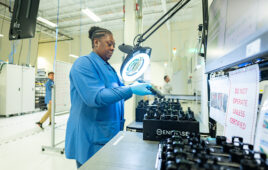 By Josh Christianson, project director, Partnership on Inclusive Apprenticeship
By Josh Christianson, project director, Partnership on Inclusive Apprenticeship
According to the United States Energy and Employment Report (USEER) 2021, much of the clean energy sector experienced job losses during the COVID-19 pandemic, and the solar industry saw an 8% decline in jobs. In 2020, the industry began rebounding, bringing an influx of 560,000 jobs into the energy sector and a continued need for solar workers. As we turn the corner into 2022, experts anticipate continued growth in solar jobs. A recent study from the U.S. Department of Energy projects that the solar industry will employ between 500,000 and 1.5 million American workers by 2035.
Though increasingly optimistic about the future outlook, many industry leaders face major hurdles to recruit and hire experienced candidates to fill the growing number of clean energy jobs. As outlined in the 2021 USEER report, 88% of companies in the electric power generation sector reported: “It was either somewhat difficult (69%) or very difficult (20%) to find new employees.” At the same time, the energy sector is “less diverse than the nation as a whole,” and employers are seeking ways to build diverse, equitable, inclusive and accessible workplaces.
Apprenticeship programs that are designed to be inclusive of people with disabilities — and underrepresented groups more broadly — can play a vital role in building out the solar industry’s future workforce. This talent pipeline offers a cadre of trained and experienced job candidates with diverse skill sets, knowledge and abilities.
Bringing in diverse talent through apprenticeship
About 26% of adults in the U.S. have a disability, but only 29.1% of people with disabilities aged 16-64 are employed. People with disabilities can bring a wealth of untapped talent and diverse perspectives into the clean energy sector, filling jobs ranging from solar power installers to systems engineers and market analysts. In fact, 10.7 million more Americans could enter the job market if companies would expand their focus on full inclusion of workers with disabilities. An apprenticeship program that is designed to be inclusive of people with disabilities can create a diverse talent pipeline of valued workers and help build a more inclusive solar industry.
Apprenticeship programs provide participants with paid “earn while you learn” training through in-classroom instruction and structured on-the-job training with an experienced mentor. Inclusive apprenticeship programs can help take apprenticeships a step further. These programs are specifically designed to be accessible to and inclusive of all trainee workers, including people with cognitive, neurological, physical, mental health and sensory disabilities. In turn, recruiting and hiring these career seekers can help to foster more diverse, equitable, inclusive and accessible workplaces.
Launching an inclusive apprenticeship program can offer a low-cost way to help companies of all sizes diversify their workforces, boost productivity, reduce turnover and absenteeism, enhance their brand images and more. All of these factors can drive a company’s mission and yield key advantages for its bottom line.
The value of inclusive apprenticeship
Creating an inclusive apprenticeship program can represent a low-cost way to build a diverse pipeline of solar workers. “The Value of Inclusive Apprenticeships,” a recently published resource from the Partnership on Inclusive Apprenticeship (PIA), summarizes the crucial advantages that these programs can bring to companies, including:
-
Significant return on investment: In 2020, the average Registered Apprenticeship program yielded a 170% return on investment for North Carolina employers. Companies that embraced best practices for employing and supporting more workers with disabilities in their workforce achieved 28% higher revenue, doubled their net income, and attained 30% higher profit margins on average.
-
Lower turnover and reduced training costs: The vast majority of apprentices (89%) maintained their positions, helping their businesses achieve a strong 3-year retention rate. At four Walgreens locations, the three-year average turnover rate was 48% higher for team members without a disability as compared to team members with a disability, saving on recruiting and training costs.
-
A wider talent pool: As noted earlier, only 29.1% of working-age adults with a disability are employed, compared with 70% of working-age adults without a disability. Nearly 11 million Americans could enter the labor force and pursue jobs, including through apprenticeships, if companies embraced full inclusion of workers with disabilities.
A path forward: Steps to creating an inclusive apprenticeship program
For those companies with an interest in creating inclusive apprenticeship programs, these five steps can help organizations kick start the process and meet their goals to become more diverse, inclusive, equitable and accessible businesses:
Step 1: Explore
Explore how apprenticeship programs can help prepare and train the future workforce by learning more about the value of inclusive apprenticeship programs and how the Partnership on Inclusive Apprenticeship is advancing career paths in the clean energy sector.
Step 2: Build
Learn how to create an apprenticeship program or partner with an existing apprenticeship program. Additionally, many states offer funding sources that can aid businesses in developing programs, providing financial support for solar workforce expansion, apprenticeship training, and work access for job seekers with disabilities. Employers can pursue several tax incentives and grant programs. Learn more about funding an apprenticeship program.
Step 3: Partner
Consider developing a new partnership to create an inclusive program, which may include collaborating with industry partners such as apprenticeship intermediaries. These intermediaries can connect apprentices and employers to help launch, grow and maintain apprenticeship programs. They are often run by industry associations, chambers of commerce, community and technical colleges, community-based organizations, labor-management partnerships and workforce development boards.
Step 4: Register
Find out how to register an apprenticeship program with the U.S. Department of Labor or a state apprenticeship agency.
Step 5: Launch
Begin an apprenticeship program by recruiting and hiring talented career seekers. Learn how to launch a program and read “Designing Inclusive Apprenticeships: A Guide for Recruiting & Training Apprentices with Disabilities.”
The Partnership on Inclusive Apprenticeship (PIA) is a project funded by the U.S. Department of Labor’s Office of Disability Employment Policy. PIA helps inform and shape policies, practices, and approaches to create a more diverse, equitable, inclusive, and accessible workplace through apprenticeship. PIA works with all types of employers large and small, including those in the clean energy sector, to advance and enhance inclusive apprenticeship programs that can help meet employers’ talent needs.






Tell Us What You Think!